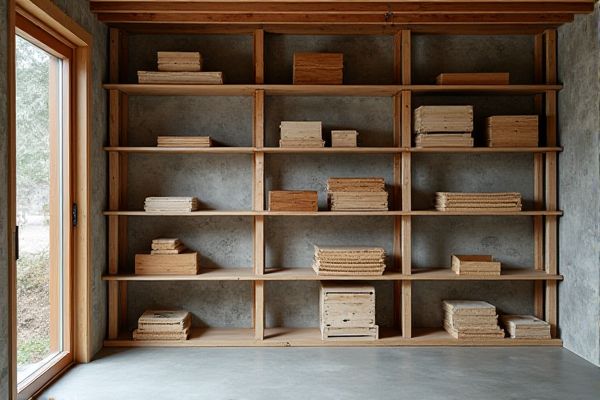
Slatted shelving offers a solid surface ideal for storing smaller items without the risk of them falling through gaps, while wire shelving provides better air circulation and moisture resistance, making it a popular choice for basements prone to humidity. To discover which type best suits your basement storage needs and how to maximize your space effectively, continue reading the article.
Table of Comparison
| Feature | Slatted Shelving | Wire Shelving |
|---|---|---|
| Material | Wood or MDF slats | Steel wire, often coated |
| Airflow | Moderate, gaps between slats | High, open wire design |
| Durability | Less moisture resistant | Rust-resistant, ideal for damp basements |
| Weight Capacity | Moderate to high | High load-bearing strength |
| Installation | Simple, often DIY-friendly | Requires assembly, adjustable heights |
| Maintenance | May require sealing/finishing | Easy to clean and maintain |
| Aesthetic | Warm, natural look | Industrial, modern appearance |
| Best Use | Dry basements, decorative storage | Damp basements, heavy-duty storage |
Introduction to Basement Shelving Solutions
Slatted shelving and wire shelving offer distinct advantages for basement storage, with slatted shelves providing solid surfaces that prevent small items from falling through, while wire shelving promotes better air circulation to reduce moisture buildup. Your choice depends on the items you need to store and the level of ventilation required to keep them safe. Both solutions optimize basement organization, balancing durability and functionality to meet your storage needs.
What Is Slatted Shelving?
Slatted shelving consists of wooden or metal planks arranged with spaced gaps, allowing air circulation and preventing dust buildup, making it ideal for basement storage areas prone to moisture. This type of shelving supports heavier items due to its solid structure while maintaining ventilation to protect stored belongings from mold and mildew. Compared to wire shelving, slatted shelves provide a sturdier, more aesthetically pleasing option for organizing basement essentials.
What Is Wire Shelving?
Wire shelving consists of metal grids or mesh panels designed to provide strong, breathable storage solutions that resist moisture and dust accumulation, making them ideal for basement environments. The open design facilitates air circulation, reducing the risk of mold and mildew in damp areas compared to solid surfaces like slatted shelving. Wire shelving systems also offer adjustable configurations and enhanced durability against corrosion, ensuring practical and long-lasting basement storage.
Installation Process: Slatted vs Wire Shelving
Slatted shelving in basements offers a straightforward installation process, typically requiring basic tools and wall anchors for secure mounting. Wire shelving involves assembling metal brackets and supports, often requiring precise measurements to ensure stability and weight capacity. Choosing between the two depends on your preference for ease of setup and the type of storage your basement requires.
Durability and Weight Capacity Comparison
Slatted shelving typically offers superior durability due to its solid wood or metal construction, making it ideal for storing heavy basement items without sagging. Wire shelving, while lighter and more affordable, may have lower weight capacity and can bend or warp under substantial load over time. Choosing the right system ensures your basement storage setup withstands heavy use and maximizes longevity.
Moisture Resistance and Airflow
Slatted shelving in basements offers superior moisture resistance due to its solid wood or metal slats, which are less prone to rust and mold growth compared to wire shelving. Wire shelving enhances airflow significantly, promoting better ventilation that helps prevent dampness and odor buildup. Choosing between the two depends on balancing the need for moisture protection with optimal air circulation in basement storage environments.
Organization and Customization Options
Slatted shelving offers superior organization with adjustable slats that accommodate various storage containers, making it ideal for customizing basement storage layouts. Wire shelving provides excellent visibility and ventilation, preventing moisture buildup and allowing easy identification of stored items. Both options support modular designs, but slatted shelves excel in tailored compartmentalization while wire shelves enhance airflow and quick access.
Maintenance and Cleaning Differences
Slatted shelving in basements features solid surfaces that resist dust accumulation and are easier to wipe down, while wire shelving allows air circulation but can trap dirt in its gaps, requiring more detailed cleaning. Wire shelves often need regular vacuuming or brushing to remove debris, whereas slatted shelves can be maintained with a simple damp cloth. The choice impacts long-term upkeep, with slatted shelves offering streamlined cleaning and wire shelving necessitating more frequent attention to prevent buildup.
Cost Analysis: Slatted vs Wire Shelving
Wire shelving typically costs less upfront compared to slatted shelving, making it a budget-friendly option for basement storage. Slatted shelving, often made from wood or metal with a higher-quality finish, tends to be more expensive due to materials and manufacturing processes. Long-term investment should consider durability and maintenance costs, where wire shelving may incur rust or bending issues in humid basements, whereas slatted shelving often withstands moisture better but requires occasional refinishing.
Best Applications and Final Recommendations
Slatted shelving excels in environments requiring sturdy, flat surfaces for heavy or small items, making it ideal for storing boxes, tools, and household goods in your basement. Wire shelving offers superior ventilation and moisture resistance, perfect for damp or humid basement conditions and for storing items like canned goods or laundry supplies. For long-term durability and flexibility, choose slatted shelving for heavy-duty organization and wire shelving to prevent mildew and maintain airflow in moisture-prone areas.
 homyna.com
homyna.com